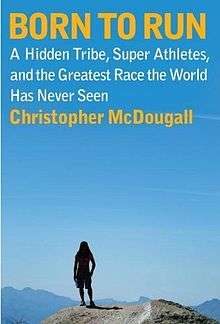Born to Run: A Hidden Tribe, Superathletes, and the Greatest Race the World Has Never Seen
Born to Run: A Hidden Tribe, Superathletes, and the Greatest Race the World Has Never Seen, is a 2009 best-selling ethnography written by the American author and journalist Christopher McDougall. The book has sold over three million copies.[1]

Narrative
In Born to Run, McDougall tracks down members of the reclusive Tarahumara Native Mexican tribe in the Mexican Copper Canyons. After being repeatedly injured as a runner himself, McDougall marvels at the tribe's ability to run ultra distances (over 100 miles) at incredible speeds, without getting the routine injuries of most American runners. The book has received attention in the sporting world for McDougall's description of how he overcame injuries by modeling his running after the Tarahumara.[2] He asserts that modern cushioned running shoes are a major cause of running injury, pointing to the thin sandals worn by Tarahumara runners, and the explosion of running-related injuries since the introduction of modern running shoes in 1972.
Alongside his research into the Tarahumara, McDougall delves into why the human species, unique among primates, has developed traits for endurance running. He promotes the endurance running hypothesis, arguing that humans left the forests and moved to the savannas by developing the ability to run long distances in order to literally run down prey.[2]
The book was on the New York Times Best Seller List for more than four months. The book was criticized by book critic Dan Zak of the Washington Post for what he thought were extraneous efforts to be "gonzo and overly clever."[3]
Film adaptation
A film adaptation of this Native American drama is in the works from LD Entertainment, and producers Lorenzo di Bonaventura and Deb Newmyer. In 2015 it was reported that Matthew McConaughey will be starring and that Matthew Michael Carnahan will write the screenplay.[4] The film has not gone into production and remains in development hell.
See also
- Micah True, an ultrarunner who appears in the book under his nickname "Caballo Blanco"
- Scott Jurek
- Jenn Shelton
- Ann Trason
- Persistence hunting
References
- McDougall, Christopher. Born to Run: A Hidden Tribe, Superathletes, and the Greatest Race the World Has Never Seen. Knopf. pp. 304. ISBN 0-307-26630-3.
- Parker-Pope, Tara. "The Human Body is Built for Distance." Well, The New York Times, October 26, 2009.
- Zak, Dan. "Running, the Natural Way." Washington Post. June 21, 2009.
- Matthew McConaughey born to run in upcoming Native American drama January 29, 2015 The Guardian Retrieved May 5, 2015